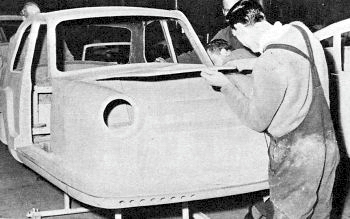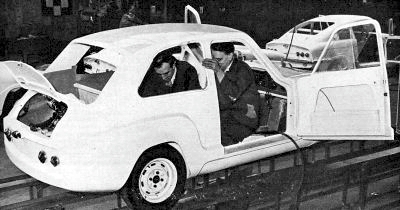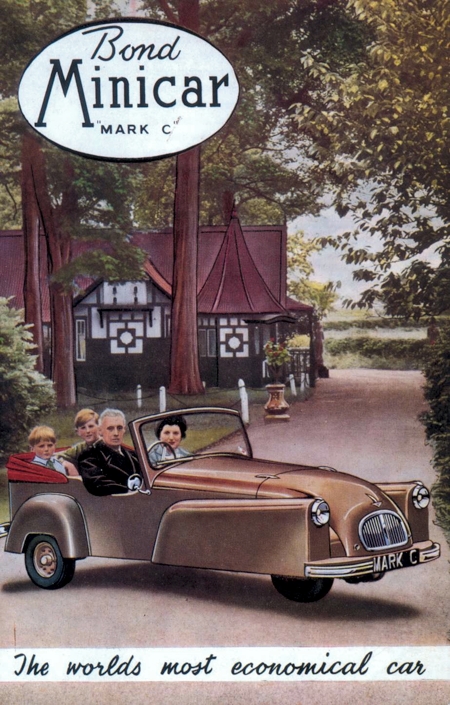Bond Minicars
|
1949
- 1966 |
Country: |
 |
Number
Built: |
24,484 |
Collectability: |
 |
|
By comparison with other firms which had tried to produce specialized cars on a small scale, during the 1960's Bond had a relatively tranquil existence and, without making a technically complex product, prospered quietly. By 1966 production of the distinctive and successful Equipe GT4S coupe was about 25 a week (1,200 a year) and the three-wheeled 875 was rapidly building up to take the place of the long line of Villiers-engined Minicars.
The first Bond, designed by Laurie Bond, but made by Sharps Commercials Ltd. at the same Ribbleton Lane factory, was revealed to its astonished motor-cycling public in autumn 1948. Conceived in an age when austerity after the Second World War was still very much part of everyday life, and when all makes of car were in extremely short supply, the first Bond was a strange device indeed! With its 122 c.c. Villiers 2-stroke
air-cooled engine, Villiers 3-speed motor-cycle gearbox, all mounted on the single front steered wheel (and turning with it), cable and bobbin
steering and a convertible two-seater monocoque aluminium body, the little car ran on tiny wheels and cost £199.
It didn't take long to grow up. By
1950 the engine was 197c.c., and in
1952 the C-type Bond appeared with enclosed headlamps and more refinement. The D-type followed, then in
1958 came the E-type with the first slab-sided body which almost looked like a real car. About this time, Bond customers could have a roof over their heads, a hardtop being optional to the convertible.
With the F-type, in
1962, came the Ranger van and an estate car, the engine being 246c.c. In March
1963 came the final development of the Villiers ranges, with a twin-cylinder 249 c.c. engine optional on the new G-type saloon, estate and van range. By the beginning of the 1960s, it was becoming clear that the low-priced, low performance three-wheelers were becoming less popular. In the preceding year or two, more than one three-wheeler firm had disappeared or changed to other products; only
Reliant seemed as healthy as Bond.
The early post-war customer, weaned off motor-cycles on to the 2-stroke-engined Minicar by the promise of more refinement and weather protection, was disappearing; his successors, not wanting motor cycles, but still attracted by the £8 licence fees and excellent fuel economy, were demanding something more advanced. A radically changed Bond would cetainly be needed. The announcement of a neat little 4-cylinder water-cooled Reliant engine in autumn 1962 made the need more urgent.
Plans for Four-wheeler
Meanwhile, managing director Tom Gratrix had other projects under way. An accountant by training and commercial director of Bond before stepping up into the M.D.'s chair, Gratrix had no illusions about the developing market. He was certainly not willing to let Bond drift down with the death of the old designs. A four-wheeler was needed, not just any design, but a
real car. To achieve any co-operation from a big manufacturer, the new Bond car would have to "fill a gap" in that manufacturer's range; it would be impossible to buy engines and transmissions if the Bond product were to compete directly when made.
 A Bond 875 on the production line, circa 1965...
A Bond 875 on the production line, circa 1965... |
Early in
1962 the project had started with thoughts of using Ford Anglia-Classic parts; this, and a later scheme to use B.M.C. A-series engines, collapsed on commercial grounds. The thought of using Triumph assemblies came later, creating a rather subtle idea. Triumph were then achieving the reputation as "gap-fillers" among the giants, so the Bond would have to be one to fill a gap in the gap fillers! The result was a clever cocktail of Herald, Spitfire and Vitesse parts, to be called the Equipe GT 2 + 2.
With the Herald Coupe out of production the Equipe fulfilled a real need. For Bond, the Leyland take-over of Triumph had been opportune. Bond and Leyland had been near neighbours for many years, and understood each other's methods. Bond's parent company - Loxhams garages group - were well respected by the hard-headed Leyland management; and so the deal was signed. Bond were to use all-Triumph mechanical parts in the Equipe, to be assembled at Preston into their own well-finished glassfibre bodyshell. The result, carrying Triumph's full mechanical guarantee, was to market through selected Triumph dealers in Great Britain.
The Equipe, when announced in May
1963, struck at a very different market from the then current G-type three-wheeler. Its sporty lines were allied to tasteful fittings, excellent seats, and one of the best glassfibre shells in the business; it was an attractive buy for the Triumph enthusiast: who needed individual looks and Triumph reliability. Success was immediate. In fact, the Equipe 2 + 2 was short lived.
A separate locking boot was needed, with more room for the rear seats; subtle revisions to the roof line, a striking twin-headlamp bonnet (Triumph 2000 parts this time), and a racy boot lid spoiler, all added up to the 4-seater GT4S. The 2+ 2 was discontinued in summer 1965. By then the GT4S had acquired the 67 b.h.p. Spitfire II engine, optional wire wheels, and a host of special equipment to order.
All this time, the three-wheeler replacement was under study. Choice of a suitable engine power pack was hampered by the legal weight restriction of 8 cwt, and the need to strive for maximum fuel economy from a more powerful engine. After considering all sorts of permutations, as with the Equipe, the Hillman Imp pack semed an ideal solution. The normal, 10 to 1 c.r. car engine would certainly have been too powerful for the proposed 3-wheeler, so Bond opted for the optional 8 to 1 c.r. version, slightly less power, and the ability to use commercial grade fuel. As with the Imp, it was tactically wise to use as many Rootes parts as possible; mechanically, in fact, the 875 was pure Imp apart from the front suspension, and mixed glassfibre-aluminium body shell.
 This is a Bond 875 on the production line, circa 1966, with an Equipe
This is a Bond 875 on the production line, circa 1966, with an Equipe
in the background... |
|
Spares and service were simple and convenient, though the 875 continued to be marketed through normal Bond three-wheeler dealers. Announced in September 1965, the 875 first reached its customers, in developed form, in June the following year. The Ribbleton Lane factory was busier than ever before. While the G-type, 2-stroke, three-wheelers were being prepared for delivery, the production line was rapidly filling up with 875s. Parallel to them were a steady stream of Equipes, built from their component parts, and not - as many had speculated - from complete chassis-engine units supplied by Standard-Triumph.
Bond exported the Equipe to Europe, and even Latin America. The big problem the factory had during these years was space.
Equipe and 875 bodies were made round the corner from the main Ribbleton Lane factory in a converted cotton mill. Eight to 10 moulds of an important pane like a bonnet or a roof were available, so that plenty of time was left for the leisurely cooling which high quality glassfibre bodies must have. Production was already limited by capacity in this mill and the original factory, but Bond bought much of the surrounding area and expanded as fast as the market (and the money) allowed. By the end of Bond Minicar production, 24,484 (all models combined) had been made.
Minicar Mark A 1949–1951
The original version had a stressed skin of aluminium and no chassis. There was no springing on the rear wheels, the suspension relying on the tyres. The
air-cooled Villiers 122 cc engine and front suspension strut was turned as a unit by the
steering mechanism which at first was a cable and bobbin system but soon replaced by a worm and sector.
They never used a rack and pinion. A three speed motorcycle type gearbox was fitted with no reverse. Braking was on the rear wheels only. The engine was started by a motorcycle type kick start. The bodies were open two seat tourers with a single bench seat and weather protection was minimal.
The headlights were separate units on stalks at the side of the car. Top speed was around 35 mph (56 km/h). In
1950 a De luxe version was announced with larger 197 cc engine and glass replacing perspex for the windscreen. An open car tested by The Motor magazine in 1949 and carrying only the driver had a top speed of 43.3 mph (69.7 km/h) and could accelerate from 0-30 mph (48 km/h) in 13.6 seconds. A fuel consumption of 72 miles per imperial gallon (3.9 L/100 km; 60 mpg-US) was recorded. The test car cost £262 including taxes.
 A Bond Minicar Mark C, circa 1954...
A Bond Minicar Mark C, circa 1954... |
Minicar Mark B 1951–1952
The Mark B at last featured rear suspension, independent using coil springs and a 197 cc engine. As well as the open car, a commercial, van, version appeared.
Minicar Mark C 1952–1956
The Mark C saw a completely new body style. The headlights were now in the wings and a door was fitted but only on the passenger side of the car. An electric starter became an option on the 197 cc villiers 8E engine. The
steering lock was increased and a worm and sector mechanism fitted replacing the rack and pinion and this allowed the engine to turn through 90 degrees allowing the car to turn in its own length so reducing the handicap of not having a reverse gear. These were the model's best years, with production rising to 100 cars per week in 1955 and a total of 14,000 produced by 1956.
Minicar Mark D 1956–1957
The Mark D was an upgrade over the mark C, gaining a Villiers 9E 197 cc engine and a 12-volt electrical system. The Family version had small hammock type rear seats.
Minicar Mark E 1958–1959
The final versions of the Minicar were a completely new design. The body, still in aluminium, was mounted onto a steel chassis. Doors were now fitted to both sides of the body and the gear box became a 4-speed. The body was offered in Family, Tourer (convertible) and Van versions with an optional glassfibre roof. The maximum speed was now around 50 mph (80 km/h).
Minicar Mark F 1959–1961
Similar to the Mark E, this model had an engine upgraded to 250 cc and 55 mph (89 km/h) top speed and optional reverse gear.[3] A closed saloon body was offered for the first time.
Minicar Mark G 1961–1966
The Mark G had a revised body with the windscreen moved forwards to give more interior room and a "reverse slope" rear window in the saloon models making the Minicar much more like a "proper car", there were even wind up windows and lockable doors. An estate car was added to the body line up and a choice of engines was offered on later mark G models – the 35A single cylinder unit (11.5 bhp) or the 4T twin cylinder unit (14 bhp). Semi hydraulic
brakes replaced the old cable and rod operated system of the predecessors and the car was fitted with larger 10" wheels.
Amoung the images shown in the above slideshow include the original Minicar, C-Type Convertible, D-Type, E-Type, F-Type and G-Type Estate.
Further Reading: Bond Car Reviews |
Bond Bug |
Bond Equipe 


